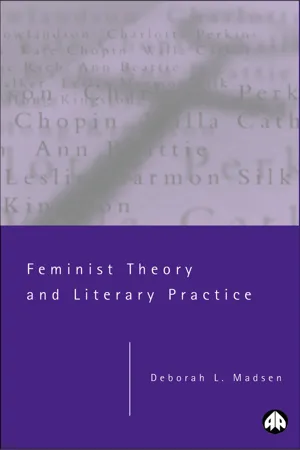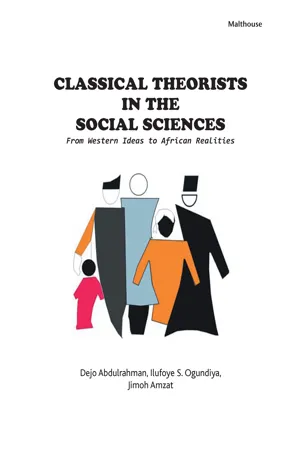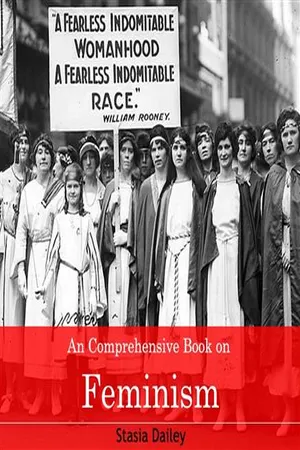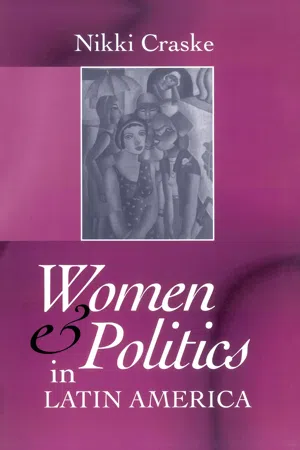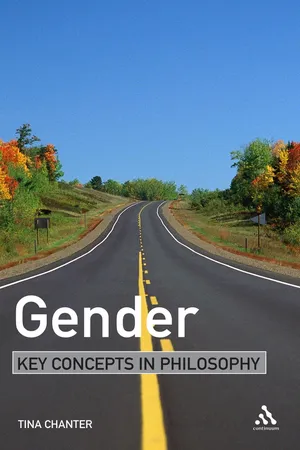History
US Feminism
US feminism refers to the ongoing social and political movement advocating for gender equality and women's rights in the United States. It has evolved over time, encompassing various waves such as first-wave feminism focused on suffrage, second-wave feminism addressing broader social and economic issues, and intersectional feminism, which emphasizes the interconnected nature of gender, race, and other forms of oppression.
Written by Perlego with AI-assistance
Related key terms
1 of 5
9 Key excerpts on "US Feminism"
- eBook - PDF
- Deborah L. Madsen(Author)
- 2000(Publication Date)
- Pluto Press(Publisher)
Introduction Feminism in America This chapter introduces the primary historical and theoretical contexts for the detailed discussions that follow in subsequent chapters. Here I set out the major historical periods of the American women’s movement, with brief analysis of the key texts produced by the theorists of those times. It is important to underline the fact that feminism in America has a long history and is not the invention of the twentieth century. Without this fundamental historical understanding, debates that continue today cannot be fully appreciated in all their intellectual complexity. It is essential that American feminism is seen not only on its own terms but fully in those terms. Thus, I begin with the pre-National and Revolutionary periods, focused upon the revolutionary decade of the 1770s, when women equated domestic tyranny with monarchical tyranny and demanded that the inalienable rights of women as well as men be addressed and inscribed in the foundational documents of the new Republic. I then move to the first wave of American feminism – the period leading up to and following the Seneca Falls Convention in 1848. Key thinkers and texts of this period include Margaret Fuller’s Woman in the Nineteenth Century (1845), the essays and speeches by Elizabeth Cady Stanton and Susan B. Anthony, and Charlotte Perkins Gilman’s Women and Economics: A Study of the Economic Relation Between Men and Women as a Factor in Social Evolution (1898), which are discussed in chapter one. The second wave of American feminism dates from the 1960s, and marks the establishment of the modern Women’s Movement. Key texts of second wave feminism include: Betty Friedan’s The Feminine Mystique (1963), discussed in chapter one, Shulamith Firestone’s The Dialectic of Sex (1970), discussed in chapter five, Kate Millett’s Sexual Politics (1971) 1 and Gloria Steinem’s Outrageous Acts and Everyday Rebellions (1983). - eBook - PDF
Classical Theorists in the Social Scienc
From Western Ideas to African Realities
- Dejo Abdulrahman(Author)
- 2023(Publication Date)
- Malthouse Press(Publisher)
Therefore, feminism could be regarded as the struggle to end sexism, sexist exploitation, and oppression (Hook, 1984). It does not privileged women over men, but seek the engagements of social movements for defining, establishing, and achieving equal opportunities for women and men in politics, economic, cultural, personal, human and social rights (Fine & John, 1994). In view of these aspirations, varying definitions of feminism have emerged. For instance, Smith (1979) defines feminism as “… the political theory and practice to free all women: women of colour, working – class women, poor women, physically challenged women, lesbians, old women, as well as white economically Classical Theorists in the Social Sciences: From Western Ideas to African Realities 380 privileged heterosexual women…” Furthermore, Brannigan (2003, p.179) opines the original meaning and impetus of feminism is “… the long-standing history of control and dominance by men throughout the world, men who have not viewed women as their equals.” Rich (1976) also claims that feminism implies women’s ability to renounce their obedience to the fathers; recognize the fact that the world the fathers’ have described is not the whole world; and recognize fully the inadequacy and the distortion of male-created ideologies so that they can proceed to think and act out of that recognition. Therefore, feminism could be sum-up as a reaction to injustice against women and girls by men and the society to which they belong. Who is a Feminist Thinker? Feminists are individuals who advocate and support the rights and equality of women in all spheres of life. They seek to establish equal opportunities for women in politics, governance, health, economics, education and employment; and to challenge all forms of unfair and unequal distribution of power and wealth in patriarchal society. They argue that women should share equally in society’s opportunities and scarce resources. - No longer available |Learn more
- (Author)
- 2014(Publication Date)
- Library Press(Publisher)
________________________ WORLD TECHNOLOGIES ________________________ Chapter- 1 History of Feminism Louise Weiss along with other Parisian suffragettes in 1935. The newspaper headline reads, in translation, THE FRENCHWOMAN MUST VOTE. The history of feminism involves the story of feminist movements. Most feminist historians assert that all movements that work to obtain women's rights should be considered feminist movements, even when they did not (or do not) apply the term to themselves. Other historians assert that the term should be limited to the modern feminist movement and its descendants. Those historians use the label protofeminist to describe earlier movements. The history of the modern feminist movement is divided into three waves. Each is described as dealing with different aspects of the same feminist issues. The first wave refers to the movement of the 19th through early 20th centuries, which dealt mainly with ________________________ WORLD TECHNOLOGIES ________________________ suffrage. The second wave (1960s-1980s) dealt with the inequality of laws, as well as cultural inequalities. The third wave of feminism (late 1980s-early 2000s), is seen as both a continuation and a response to the perceived failures of the second wave. Introduction The term feminism first appeared in France in the 1880s (as féminisme ), Great Britain in the 1890s, and the United States in 1910. The Oxford English Dictionary lists 1894 for the first appearance of feminist and 1895 for feminism. The UK Daily News first introduced feminist to the English language, importing it from France and branding it as dangerous. What our Paris Correspondent describes as a 'Feminist' group... in the French Chamber of Deputies. Prior to that time, Woman's Rights was probably the term used most commonly, hence Queen Victoria's description of this mad, wicked folly of 'Woman's Rights'. - eBook - PDF
- Margaret F. Bello(Author)
- 2019(Publication Date)
- Society Publishing(Publisher)
This chapter discusses the history of feminism. While feminism movement was gaining a foothold, an anti-feminist movement began, which opposed the principles of the feminist movement. This chapter discussed the Anti-Feminist movement as well. The chapter also elaborates the fact that feminism is an effective tool for empowering women. Feminism often falls prey to some misinterpretation which results in a lot of deliberations and objection to the feminism movement. This chapter discusses these misinterpretations that fuel the anti-feminist movement. This chapter also covers the main issues that modern feminism has to overcome. Although the feminist movement has achieved much and fought for the equal right of women, it has its share of criticism, which has been discussed in this chapter. Finally, toxic feminism has been explained as a rising threat to the society. This chapter ends on the note that there is a need for gendered men human security. 7.1. INTRODUCTION Feminism is a social movement that aims for economic, social, and political rights for women. The idea of feminism is based on the notion that men and women are equal. Hence, they deserve equal rights in the society. The feminist movement in the past has achieved a lot and made immense contribution to the empowerment of women. It granted them voting rights, the right to works and a right to live a violence-free life. Although it appears that society has granted equal status to men and women, an introspection of the majority of challenges that women face can be linked to gender inequality that exists in the society. Statistics indicate that: • Women earn only 80 cents for every dollar a man earns for the same job. • Women form almost 50% of the population, but do not have the same representation in political leadership. • 1 in 3 women around the world has experienced violence in some form. These are just a few facts that prove that women empowerment still has a long road to travel. - eBook - PDF
- Nikki Craske(Author)
- 2013(Publication Date)
- Polity(Publisher)
Liberal feminists, however, have also had an impact, and their emphasis on equal opportunities, with special help to allow women to‘catch up’ with men, has also been influ-ential. Maternal feminism as a concept, paralleling‘female con-sciousness’, emphasizes women’s contribution to national life through their‘[devotion] to the protection of vulnerable human life’ (Elshtain, in Dietz, 1989: 11). This clearly resonates with the relationship between motherhood and political organization in social movements, although activists tend not to refer to‘maternal feminism’ as such. Popular feminism, which emerged from social movements, concentrates on class and gender, rather than mother-hood per se. While the divisions between these different perspectives can lead to heated debates, witnessed during the regional meetings (see below), there can be common goals. Most people who would claim to be feminist are interested in changing the position of women, and‘feminism in general [is] to attempt to transform women from an object of knowledge into a subject capable of appropriating knowledge, to effect a passage from the state of sub-jection to subjecthood’ (Delmar, 1986: 25). This parallels the devel-opment of citizenship in the region. This definition, of course, could include many who would spurn the label feminist. Similarly, 166 Feminisms in Latin America there are women’s groups which appear to have the same demands, some of which would use the term feminist and others which would not. It is indeed difficult to give a fixed definition to the term, particularly given that it has become increasingly con-tested over the years. Here I refer to feminists as people and organ-izations who question women’s structural subordination within society and seek not just to ameliorate the conditions but to develop an alternative set of structures which would undermine such subordination. - eBook - PDF
- Nancy S. Love(Author)
- 2006(Publication Date)
- CQ Press(Publisher)
“Egalitarian,” “humanist,” and “womanist” are among the alternatives under consideration. Some have proposed reclaiming “feminism,” taking it back and making it work for women, just as gays have reappropriated “queer.” 6 A reexamination of the history of feminism, especially its more exclu-sionary moments, places these projects of renaming and reclaiming in their larger political context. Typical histories discuss three major waves of feminist struggles: (1) the suf-frage movement of the late nineteenth and early twentieth centuries; (2) the fight for equality in the sixties and seventies; (3) the politics of bodies, identities, and solidarities from the late eighties to the present. 7 The three waves overlap, and shared experiences among women sometimes supercede generational (and other) differences between them. Within each wave, while some women were struggling for equality with men, others were stressing women’s differences from men. These different strategies overlap with other disagreements between women differently positioned by class, ethnicity, nationality, race, religion, and/or sexuality. Indeed, some argue that the wave metaphor mistakenly organ-izes feminist history around Western categories. At its best, however, the wave metaphor is not simply a chronology of Western feminism, but also an image of feminists’ multiple sites of contestation. 8 The first wave began in the mid-nineteenth century, when American and European women organized to fight for suffrage. American feminism became an organized movement in 1848 at the Seneca Falls Women’s Rights Conven-tion. Seventy-two years had elapsed since 1776, when Abigail Adams exhorted 168 feminism her husband John to “Remember the Ladies” and declared that we “will not hold ourselves bound by any Laws in which we have no voice or Represen-tation.” 9 Lucretia Mott and Elizabeth Cady Stanton organized the Seneca Falls convention after they were prevented from speaking at the 1840 World Anti-Slavery Convention. - eBook - PDF
The Retreat from Organization
U.S. Feminism Reconceptualized
- Elisabeth Armstrong(Author)
- 2012(Publication Date)
- SUNY Press(Publisher)
The NWSA conference on feminism and racism, held in 1981, starkly revealed that a meaningfully plural category women did not evolve quietly in feminist dis- course. 2 The struggle to define what women in feminism signifies was often as fe- rocious as the covert resistance to a pluralist category women. The synopses of these wide-ranging debates over the political project of feminism often center on two issues: the inclusion of diverse experiences into feminism, and an understanding of women through crosshatched relations of oppression and exploitation. Often, the issue of inclusion is reduced to a single question, remembering the outraged query to feminism: Inclusion of whom? Invocations and analyses of this question are richly explored in feminist scholarship. Feminist theory answers “inclusion of whom?” 34 T H E R E T R E A T F R O M O R G A N I Z A T I O N when it locates its analytic subjects, clarifies the range of social processes at work, and most of all when it does not generalize women. Feminist theorists answer the question of inclusion in terms of the subject and subjectivity of politics. With some exceptions, feminists have forgotten its historical precedent, a question also ad- dressed to feminism: Inclusion in what? This question opens up the site of politi- cal engagement and the movement. Just as importantly, theoretical investigations of movement and politics map the trajectories of existing political tendencies and develop alternative political models. This chapter has two parts. First, I examine the limitations of pluralism illus- trated by the 1981 NWSA conference on feminism and racism. I argue that plu- ralist concepts of inclusion and full representation both accommodate and under- mine antiracist positions. While not necessarily individualist, pluralism privileges the subject as the site for politics. - eBook - PDF
- Tina Chanter(Author)
- 2006(Publication Date)
- Continuum(Publisher)
CHAPTER 1 FORMATIVE MOMENTS AND CONCEPTS IN THE HISTORY OF FEMINISM Feminist theorists have put a good deal of energy into trying to combat traditional gender ideologies and to overcome naturalizing claims about women’s innate inferiority to men or female irrationality. Even as we point out the limiting role it has played in some circles, we must also acknowledge that the distinction between sex and gender has served the feminist movement well. It has played a crucial role in establishing parity in the workplace, for example. Once the idea that women are innately incapable of reasoning well, or naturally unsuited to the rigors of public life, is put to rest, it quickly becomes clear that what stands in the way of women’s progress is convention, tradition, or opinion, rather than nature, biology, or physiology. Early feminist arguments focused upon the unfairness of the fact that women were excluded from some central activities crucial to humanity – the de fi ning activities of modern political identity – which men appeared to be granted by natural fi at. These included the right to take an active role in politics, government, and leader-ship; the right to political representation; the right to education; the right to self-de fi nition; the right to legal ownership, and the right to bequeath an inheritance. Arguably, then, the modern feminist move-ment began as a movement that tried to establish parity with men. There are however a number of reasons to be wary of de fi ning fem-inism as a movement to achieve equality. If we assume that feminism aims to accomplish the equality of women with men, the question arises, which men? With whom do women want equality? Presumably feminists are not striving to be the equals of oppressed, disenfran-chised, or disadvantaged men. It becomes clear then that an inexplicit assumption built into the idea that feminists should strive for equal-ity with men is that women seek equality with privileged men. Since 8 - eBook - PDF
- Nancy F. Cott(Author)
- 2012(Publication Date)
- De Gruyter Saur(Publisher)
Thus, colonial and early nineteenth-century female reformers directed their activities into channels which were merely an extension of their domestic concerns and traditional roles. They taught school, cared for the poor, the sick, the aged. As their consciousness developed, they turned their attention toward the needs of women. Becoming woman-oriented, they began to uplift prostitutes, organize women for abolition or temperance and sought to upgrade female education, but only in order to equip women better for their traditional roles. Only at a later stage, growing out of the recognition of the separate interests of women as a group, and of their subordinate place in society, did their consciousness become woman-defined. Feminist thought starts at this level and encompasses the active assertion of the rights and grievances of women. These various stages of female consciousness need to be considered in historical analysis. The next level of conceptualizing women's history has been contribution history: describing women's contribution to, their status in, and their oppression by male-defined society. Under this category we find a variety of questions being asked: What have women contributed to abolition, to reform, to the Progressive movement, to the labor movement, to the New Deal? The movement in question stands in the foreground 204 HISTORY OF WOMEN IN THE UNITED STATES of inquiry; women made a contribution to it; the contribution is judged first of all with respect to its effect on that movement and secondly by standards appropriate to men. The ways in which women were aided and affected by the work of these great women, the ways in which they themselves grew into feminist awareness, are ignored.
Index pages curate the most relevant extracts from our library of academic textbooks. They’ve been created using an in-house natural language model (NLM), each adding context and meaning to key research topics.
